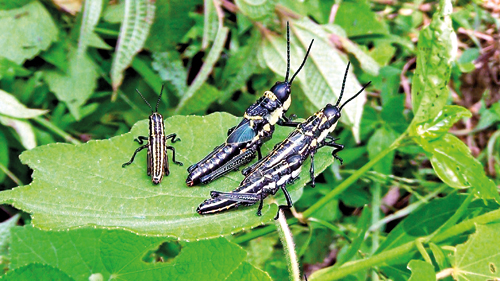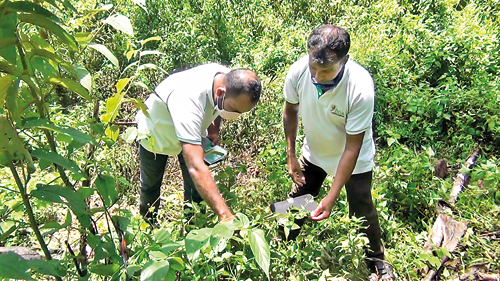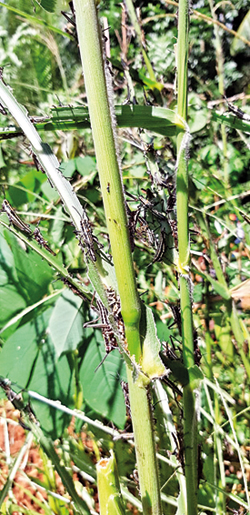News
Locust plague feared as pest reported in new areas
 An alarm has been sounded for agriculture over sightings of yellow-spotted locusts in many areas outside their normal habitats of jungles and domestic gardens.
An alarm has been sounded for agriculture over sightings of yellow-spotted locusts in many areas outside their normal habitats of jungles and domestic gardens.
“They have not reached any of the main cultivation areas but we’re on alert: farmers have been made aware of this news and have been advised on how the locusts should be eradicated in the event that it affects cultivation,” the Director of the Agriculture Department, Dr. W.M.W. Weerakoon said.
The hotline number 1920 has been set up for farmers and others to call the department about sightings of the locusts.
“In the 22 years of my profession I have not seen heavy infestations in coconuts that required spraying of chemicals to control the locusts. They have always been controlled on their own,” the Principal Entomologist of the Coconut Research Institute (CRI), Dr. Nayanie Aratchige, said.

Locust- infested areas in Hambantota. Pix by Rahul Samantha
She said the locusts currently found in Sri Lanka are not the kind that wreak havoc in India, Pakistan and African countries. “Morphologically and behaviourally these two groups of locusts are different,” she said. “The desert locust has become a menace in North India and in the African continent, but it’s not the same kind that’s found here.”
Dr. Aratchige said the yellow-spotted locust is commonly found in Sri Lanka from March to October. Its main food is teak, coconut, arecanut, banana and jak trees, although it had many other host plants.
“They mostly feed on coconut plantations close to jungles and places where weeds are not controlled,” she said.
According to reports from farmers and villagers, this year the population has increased and as a result were feeding into other nearby crops.
Dr. Aratchige believes climate change may have induced the population increase. “They cannot spread yet because they are still in their immature stage,” she said.
They mature into adults during August and gradually gain the ability to fly.
Dr. Aratchige said that controlling the pest at this stage is convenient and effective as they feed on shrubs in the lower layers.
“Once they mature they will fly into taller trees and thereby the controlling of the pest will be not easy. More toxic chemicals will be necessary to control the pest and it will be expensive too,” she said.
It is the first time the CRI has received reports of locust infestation in coconut plantations in the Matara and Hambantota districts as the usual outbreaks are reported from the Kegalle, Kurunegala and Puttalam districts. Dr. Aratchige also said from the reports she received, the locusts reported from Kilinochchi are not the yellow-spotted locust but a different species.
The CRI encourages farmers to use methods other than synthetic insecticides. These include making a bonfire to attract the insects, then collecting them in a gunny bag and destroying them.
Dr. Aratchige said that spraying chemicals not only damages the environment but also affects other insects in the coconut crown that are beneficial for coconut production such as the honey bee which helps in pollination.

Locust seen in Mawanella. Pic by Saman Wijeyabandara
In places where these pests have exposed crops to the risk of infestation the CRI has advised the use of low-toxicity insecticides.
Dr. Aratchige pointed out that the farmers in areas where locusts are found should plough their land during November and December because the insects lay eggs in October-November, and by ploughing shortly afterwards the eggs would be destroyed.
“These insects have not yet penetrated to vegetable and paddy cultivations. If that happens there might be food shortages,” the National Organiser of the All-Island Farmers Federation Namal Karunaratne said.
According to him there is danger lurking because most of the vegetables are short-term crops and paddy was a seasonal crop. If they are affected now, the supply of these crops will be halted until they are grown again.
He explained this insect was far more destructive than the sena caterpillar because it damages a vast variety of crops unlike the sena caterpillar, which feeds mostly on maize cultivations.
“We have to educate farmers and the public to refrain from using insecticides and encourage them to use more eco-friendly ways to destroy the pest,” he added.
Environmentalist Supun Lahiru Prakash told the Sunday Times that climate change had caused significant insect destruction in the world.
“Most of these insects have adapted to environments that it usually cannot survive in, for instance the desert locust, which is generally highly prevalent in deserts, which means it can only survive in very hot environments but now it has adapted to survive in areas other than deserts,” he explained.
Mr. Prakash said the yellow-spotted locust was not an invasive alien species but this year its numbers had multiplied and the environment was susceptible to such drastic change.
“Proper investigation must be carried out in order to control the numbers because they feed on crops and Sri Lanka greatly depends on agriculture as a means of livelihood to many,” he said.


